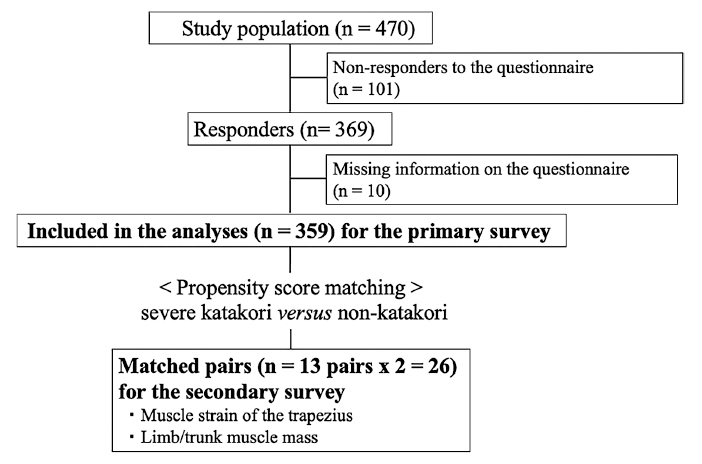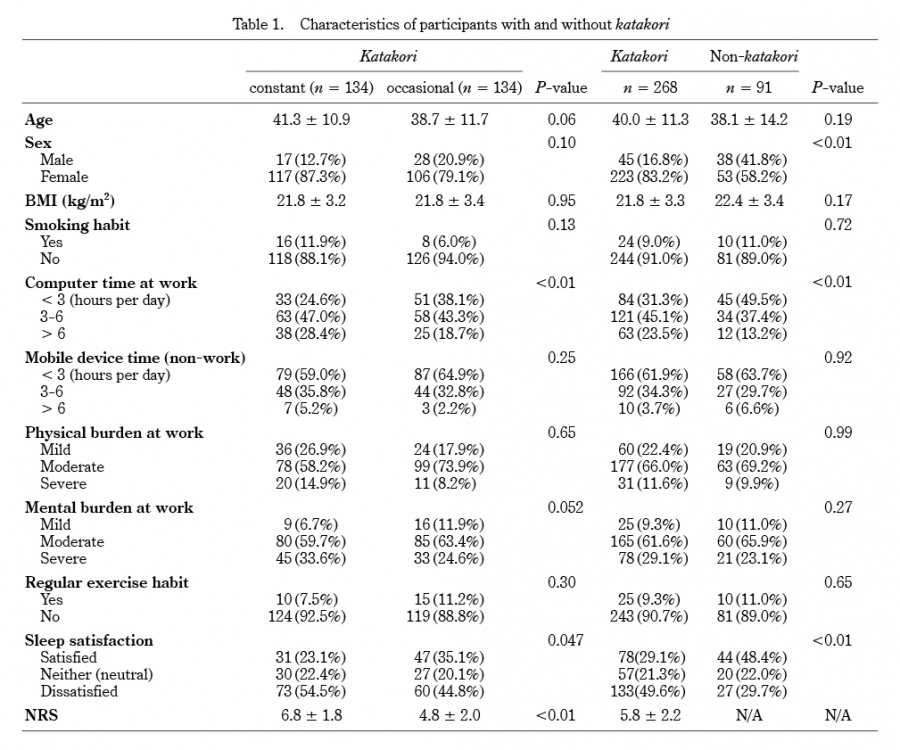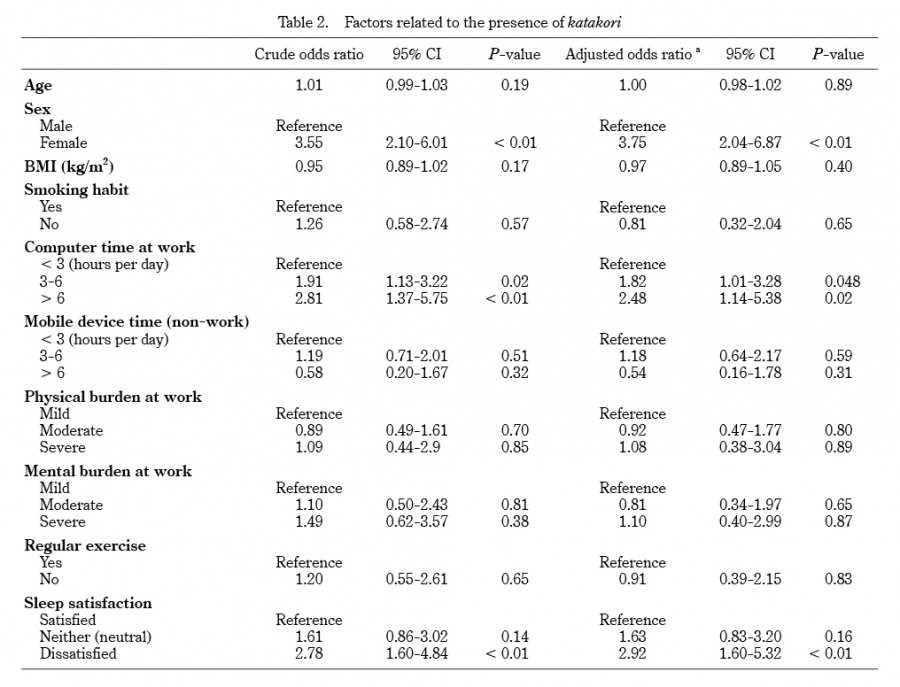1. Ministry of Health, Labour and Welfare. Japan:Comprehensive Survey of Living Conditions;No. 14. Available from:https://www.mhlw.go.jp/english/database/db-hss/cslc-Tables.html. Accessed September, 2021.
2. Côté P, van der Velde G, Cassidy JD, et al. The burden and determinants of neck pain in workers:results of the Bone and Joint Decade 2000-2010 Task Force on Neck Pain and Its Associated Disorders. Spine, 33(4 Suppl):S60-74, 2008.
3. Fujii T, Matsudaira K, Yoshimura N, Hirai M, Tanaka S. Associations between neck/shoulder discomfort (Katakori) and job demand, job control, and worksite support. Mod Rheumatol, 23:1198-1204, 2013.
4. Iizuka Y, Shinozaki T, Kobayashi T, et al. Characteristics of neck/shoulder pain (called katakori in Japanese) among members of the nursing staff. J Orthop Sci, 17:46-50, 2012.
5. Kimura T, Tsuda Y, Uchida S, Eboshida A. Association of perceived stress and stiff neck/shoulder with health status:multiple regression models by gender. Hiroshima J Med Sci, 55:101-107, 2006.
6. Sawada T, Matsudaira K, Muto Y, Koga T, Takahashi M. Potential risk factors for onset of severe neck/shoulder discomfort (Katakori) in urban Japanese workers. Ind Health, 54:230-236, 2016.
7. Takasawa E, Yamamoto A, Kobayashi T, et al. Characteristics of neck/shoulder pain in the Japanese general population. J Orthop Sci, 20:403-409, 2015.
8. Holm LW, Bohman T, Lekander M, Magnusson C, Skillgate E. Risk of transition from occasional neck/back pain to long-duration activity limiting neck/back pain:A cohort study on the influence of poor work ability and sleep disturbances in the working population in Stockholm County. BMJ Open, 10:e033946, 2020.
9. Chen Q, Bensamoun S, Basford JR, Thompson JM, An KN. Identification and quantification of myofascial taut bands with magnetic resonance elastography. Arch Phys Med Rehabil, 88:1658-1661, 2007.
10. Chen Q, Wang HJ, Gay RE, et al. Quantification of myofascial taut bands. Arch Phys Med Rehabil, 97:67-73, 2016.
11. Akagi R, Kusama S. Comparison between neck/shoulder stiffness determined by shear wave ultrasound elastography and a muscle hardness meter. Ultrasound Med Biol, 41:2266-2271, 2015.
12. Yabuki S, Kikuchi S. Pathogenesis of the neck/shoulder stiffness. (in Japanese) Rinsho Seikeigeka (Clinical Orhtopaedic Surgery), 36:1241-1246, 2001.
13. Ishikawa H, Muraki T, Morise S, et al. Changes in stiffness of the dorsal scapular muscles before and after computer work:a comparison between individuals with and without neck/shoulder complaints. Eur J Appl Physiol, 117:179-187, 2017.
14. Kuo WH, Jian DW, Wang TG, Wang YC. Neck muscle stiffness quantified by sonoelastography is correlated with body mass index and chronic neck pain symptoms. Ultrasound Med Biol, 39:1356-1361, 2013.
15. Sawada T, Okawara H, Nakashima D, et al. Reliability of trapezius muscle hardness measurement:A comparison between porTable muscle hardness meter and ultrasound strain elastography. Sensors, 20:7200, 2020.
16. Taş S, Korkusuz F, Erden Z. Neck muscle stiffness in participants with and without chronic neck pain:A shear-wave elastography study. J Manipulative Physiol Ther, 41:580-588, 2018.
17. Fujimoto K, Inage K, Eguchi Y, et al. Use of bioelectrical impedance analysis for the measurement of appendicular skeletal muscle mass/whole fat mass and its relevance in assessing osteoporosis among patients with low back pain:A comparative analysis using dual X-ray absorptiometry. Asian Spine J, 12:839-845, 2018.
18. Kawakubo A, Miyagi M, Fujimaki H, et al. Relationships between spinal alignment and muscle mass in osteoporosis patients over 75 years of age who were independent and maintained their activities of daily living. Cureus, 13:e15130, 2021.
19. Tanaka S, Ando K, Kobayashi K, et al. A low phase angle measured with bioelectrical impedance analysis is associated with osteoporosis and is a risk factor for osteoporosis in community-dwelling people:the Yakumo study. Arch Osteoporos, 13:39, 2018.
20. Vogt MT, Simonsick EM, Harris TB, et al. Neck/shoulder pain in 70- to 79-year-old men and women:findings from the Health, Aging and Body Composition Study. Spine J, 3:435-441, 2003.
21. Koo TK, Li MY. A guideline of selecting and reporting intraclass correlation coefficients for reliability research. J Chiropr Med, 15:155-163, 2016.
22. Parihar JK, Jain VK, Chaturvedi P, Kaushik J, Jain G, Parihar AK. Computer and visual display terminals (VDT) vision syndrome (CVDTS). Med J Armed Forces India, 72:270-276, 2016.
23. Ye Z, Abe Y, Kusano Y, et al. The influence of visual display terminal use on the physical and mental conditions of administrative staff in Japan. J Physiol Anthropol, 26 (2):69-73, 2007.
24. Elcadi GH, Forsman M, Crenshaw AG. The relationship between oxygenation and myoelectric activity in the forearm and shoulder muscles of males and females. Eur J Appl Physiol, 111:647-658, 2011.
25. Binderup AT, Arendt-Nielsen L, Madeleine P. Pressure pain sensitivity maps of the neck-shoulder and the low back regions in men and women. BMC Musculoskelet Disord, 11:234, 2010.
26. Generaal E, Vogelzangs N, Penninx BW, Dekker J. Insomnia, sleep duration, depressive symptoms, and the onset of chronic multisite musculoskeletal pain. Sleep, 40, 2017.
27. Gustafsson ML, Laaksonen C, Aromaa M, Löyttyniemi E, Salanterä S. The prevalence of neck-shoulder pain, back pain and psychological symptoms in association with daytime sleepiness - a prospective follow-up study of school children aged 10 to 15. Scand J Pain, 18:389-397, 2018.
28. Haack M, Sanchez E, Mullington JM. Elevated inflammatory markers in response to prolonged sleep restriction are associated with increased pain experience in healthy volunteers. Sleep, 30:1145-1152, 2007.
29. Cerezo-Téllez E, Torres-Lacomba M, Mayoral-Del Moral O, Sánchez-Sánchez B, Dommerholt J, Gutiérrez-Ortega C. Prevalence of myofascial pain syndrome in chronic non-specific neck pain:A population-based cross-sectional descriptive study. Pain Med, 17:2369-2377, 2016.
30. Nakamura T, Murakami G, Noriyasu S, Yoshio M, Sato I, Uchiyama E. Morphometrical study of arteries and veins in the human sheet-like muscles (pectoralis major, latissimus dorsi, gluteus maximus and trapezius) with special reference to a paradoxical venous merging pattern of the trapezius. Ann Anat, 188:243-253, 2006.
31. Larsson R, Öberg ÅP, Larsson SE. Changes of trapezius muscle blood flow and electromyography in chronic neck pain due to trapezius myalgia. Pain, 79:45-50, 1999.




